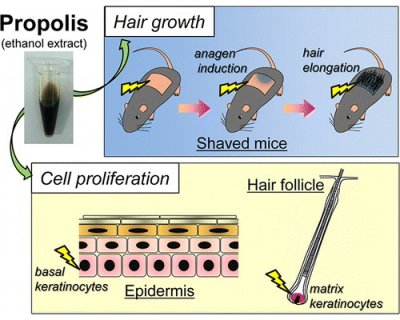Could honeybees hold the key to reversing hair loss? © Sherjaca / shutterstock.com
The resin-like material is used by honeybees to seal small crevices in their hives. Its anti fungal and anti bacterial properties are already documented but according to the research team [1], it could also contain important clues for reversing hair loss in humans. Spring-boarding on recent research suggesting propolis could promote the growth of cells that contribute to hair growth, Ken Kobayaski and his team were curious to find out if it could actually create new locks.
Hair keratinocyte proliferation
They prepped their mice by either shaving or waxing them, and in both cases those that had received a topical application of propolis grew their fur back faster than those that didn’t. Importantly, the number of cells involved in hair growth increased after propolis had been applied to the skin. “Propolis stimulates hair growth by inducing hair keratinocyte proliferation,” concluded the researchers.
Anti-inflammatory elements
While propolis was only tested on mice that were capable of growing fur rather than balding mice, the research team points out that hair loss is often the result of inflammation. Because it contains anti-inflammatory elements, the researchers say they expect propolis to reverse hair loss, although they acknowledge that further testing is necessary.
Propolis induces hair keratinocyte proliferation, according to the study published in the Journal of Agricultural and Food Chemistry.
Propolis, which also has antifungal properties, was used to treat inflammation and wounds in ancient times.
The study was published in the Journal of Agricultural and Food Chemistry.
With AFP/Relaxnews
Footnotes
[1] Shota Miyata , Yozo Oda , Chika Matsuo, Haruto Kumura, and Ken Kobayashi, Laboratory of Dairy Food Science, Research Faculty of Agriculture, Hokkaido University, Sapporo 060-8589, Japan




